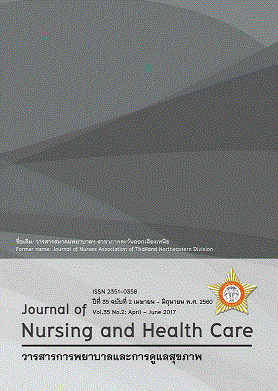ปัจจัยที่สัมพันธ์กับการจำกัดเกลือในผู้ป่วยหัวใจล้มเหลว Factors Associated with Salt Restriction among Patients with Heart Failure
คำสำคัญ:
แบบแผนความเชื่อด้านสุขภาพ แรงสนับสนุนทางสังคม การจำกัดเกลือ หัวใจล้มเหลว health belief model, social support, salt restriction, heart failureบทคัดย่อ
บทคัดย่อ
การศึกษานี้เป็นการวิจัยเชิงพรรณนาแบบภาคตัดขวาง มีวัตถุประสงค์เพื่อศึกษาความสัมพันธ์ระหว่างการจำกัดเกลือและปัจจัยคัดสรรที่มีความสัมพันธ์กับการจำกัดเกลือ ได้แก่ แบบแผนความเชื่อด้านสุขภาพ ความรู้ แรงสนับสนุนทางสังคม เพศ อายุ รายได้ ระดับการศึกษา และระดับความรุนแรงของภาวะหัวใจล้มเหลว กลุ่มตัวอย่าง คือ ผู้ป่วยที่มีภาวะหัวใจล้มเหลวจำนวน 113 คน ที่มาตรวจรักษา ณ ห้องตรวจคลินิกโรคหัวใจโรงพยาบาลชัยภูมิ ระหว่างเดือนตุลาคม และพฤศจิกายน 2559 เก็บรวบรวมข้อมูลโดยใช้แบบสอบถามที่ผู้วิจัยพัฒนาขึ้นตามกรอบแนวคิดการวิจัย แบบสอบถามที่ใช้ผ่านการตรวจสอบความตรงเชิงเนื้อหาได้ดัชนีความตรงเชิงเนื้อหา (Content validity index: CVI) เท่ากับ 0.97 และวิเคราะห์ความเชื่อมั่นภายในโดยใช้สูตร Kuder-Richardson และการหาสัมประสิทธิ์อัลฟาครอนบาค (Cronbach's alpha coefficient) ได้เท่ากับ 0.71 และ 0.79 ตามลำดับ
ผลการวิจัยพบว่า กลุ่มตัวอย่างเป็นเพศชายร้อยละ 51.32 และหญิงร้อยละ 48.68 มีอายุระหว่าง 31-87ปี โดยร้อยละ 37.17 มีอายุมากกว่า 70 ปี กลุ่มตัวอย่างส่วนใหญ่จบการศึกษาชั้นประถมศึกษา (ร้อยละ 75.22) และมีรายได้น้อยกว่าหรือเท่ากับ 5,000 บาทต่อเดือน (ร้อยละ 68.14) กลุ่มตัวอย่างมีการจำกัดเกลืออยู่ในระดับปานกลาง (Mean = 25.03, SD = 3.32) เมื่อนำผลมาวิเคราะห์หาความสัมพันธ์ และวิเคราะห์ถดถอยเชิงพหุคูณพบว่า ปัจจัยที่มีความสัมพันธ์กับการจำกัดเกลืออย่างมีนัยสำคัญ ได้แก่ ระดับการศึกษาที่สูงกว่าประถมศึกษา (p = 0.003) ระดับความรุนแรงของภาวะหัวใจล้มเหลวตั้งแต่ NYHA class 2 ขึ้นไป (p = 0.009) แรงสนับสนุนทางสังคมในการจำกัดเกลือ (p = 0.001) การรับรู้โอกาสเสี่ยงจากการไม่จำกัดเกลือ (p = 0.001) และการรับรู้สมรรถนะแห่งตนในการจำกัดเกลือ (p = 0.014) ในผู้ป่วยหัวใจล้มเหลว ผลการศึกษานี้แสดงให้เห็นว่าบุคลากรสุขภาพควรประเมินปัจจัยที่เกี่ยวข้องก่อนทำการให้ความรู้ทางด้านสุขภาพที่มุ่งเน้นปรับพฤติกรรมการบริโภคเกลือในผู้ป่วยหัวใจล้มเหลว โดยใช้ข้อมูลที่ประเมินได้เป็นพื้นฐานเพื่อส่งเสริมความสำเร็จในการปรับพฤติกรรมต่อไป
Abstract
The purpose of this cross-sectional research is to investigate an association between salt restriction and various selected factors including the health belief model (HBM) factors, knowledge, social support, gender, age, income, education level, and heart failure severity. Study sample included 113 patients with heart failure who received medical service at cardiovascular clinic of Chaiyaphum Provincial Hospital between November and October 2016. Data were collected by administering a newly developed questionnaires based on conceptual framework of the study. The content validity index of 0.97 was yielded as a result of questionnaire’s validity appraisal. The Kuder-Richardson formula analysis and Cronbach’s alpha coefficient of 0.71 and 0.79, respectively confirmed internal consistency of the questionnaire’s reliability.
Findings showed approximately equal numbers of male and female patients (51.32% and 48.68, respectively) who participated in this study. The participants had their age ranged between 31-87 years; in which 37.17% of them were older than 70 years old. Approximately 75.22% of samples had a primary school level of education. Most of the samples (68.14%) earned low incomes (< 5,000 baht per month). The samples demonstrated moderate level of salt restriction (Mean = 25.03, SD = 3.32). Correlation analysis and multiple regression analysis revealed a significant association between salt restriction and 5 selected factors including education level higher than primary school (p = 0.003), heart failure severity of NYHA class II and above (p = 0.009), social support related to salt restriction (p = 0.001), perceived susceptibility of salt non-restriction (p = 0.001), and salt restriction self-efficacy (p= 0.014) among patients with heart failure. In summary, study finding illustrates the importance of reviewing relevant factors prior to provide health education in order to modify salt consumption behavior among patients with heart failure. The reviewed information should be used as basic foundation to promote successful behavior modification.


